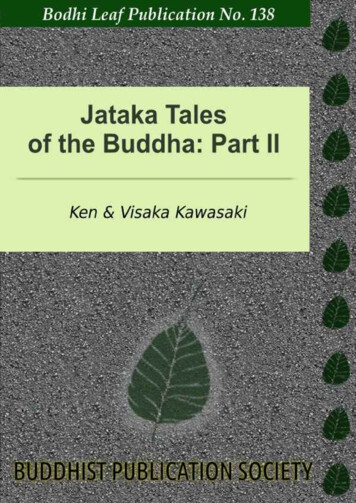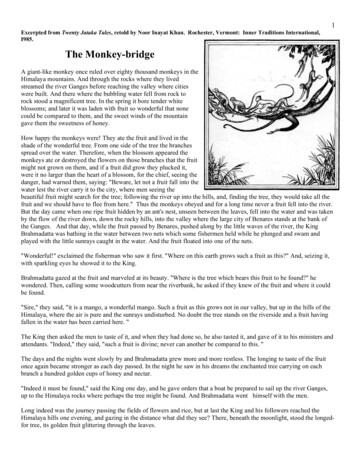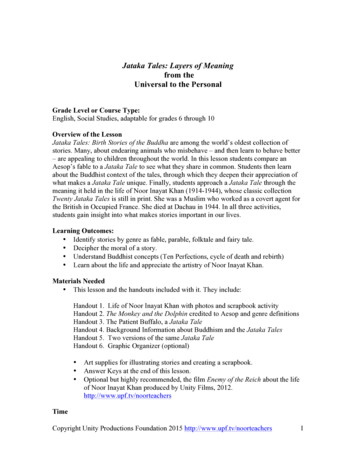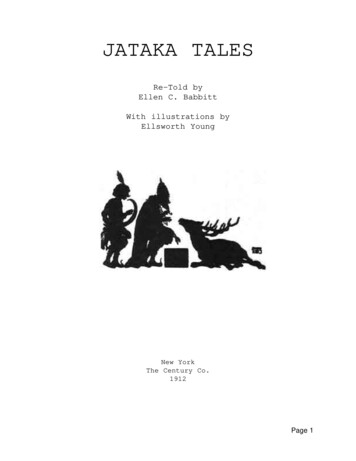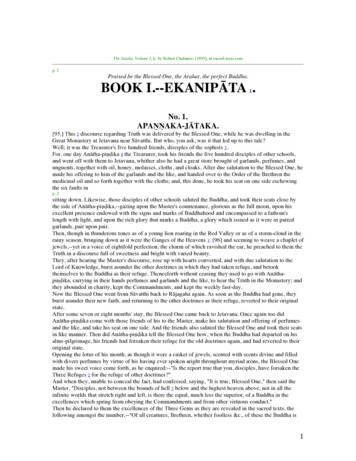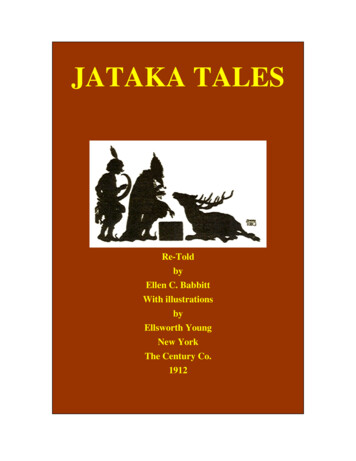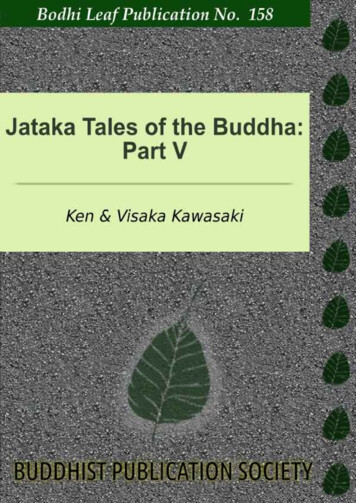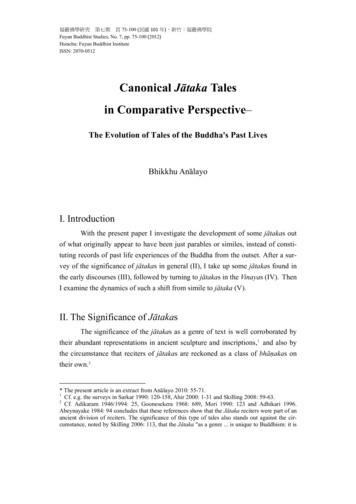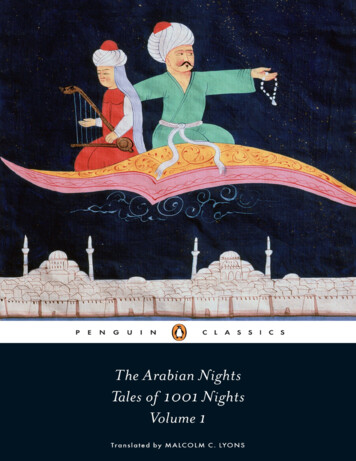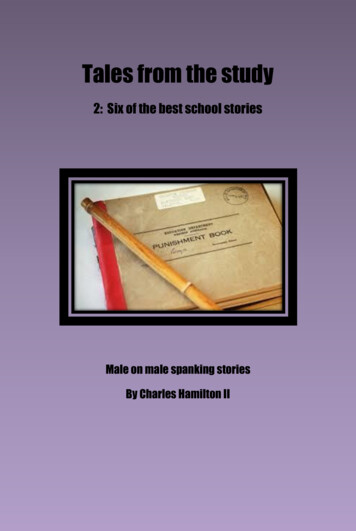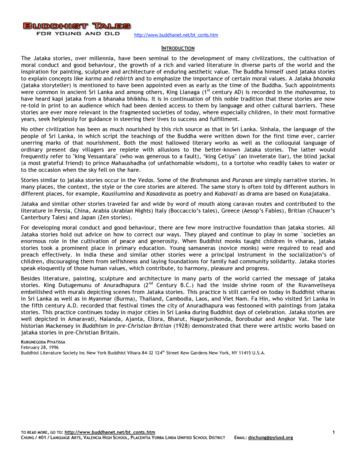
Transcription
http://www.buddhanet.net/bt conts.htmINTRODUCTIONThe Jataka stories, over millennia, have been seminal to the development of many civilizations, the cultivation ofmoral conduct and good behaviour, the growth of a rich and varied literature in diverse parts of the world and theinspiration for painting, sculpture and architecture of enduring aesthetic value. The Buddha himself used jataka storiesto explain concepts like karma and rebirth and to emphasize the importance of certain moral values. A Jataka bhanaka(jataka storyteller) is mentioned to have been appointed even as early as the time of the Buddha. Such appointmentswere common in ancient Sri Lanka and among others, King Llanaga (1st century AD) is recorded in the mahavamsa, tohave heard kapi jataka from a bhanaka bhikkhu. It is in continuation of this noble tradition that these stories are nowre-told in print to an audience which had been denied access to them by language and other cultural barriers. Thesestories are ever more relevant in the fragmented societies of today, where especially children, in their most formativeyears, seek helplessly for guidance in steering their lives to success and fulfillment.No other civilization has been as much nourished by this rich source as that in Sri Lanka. Sinhala, the language of thepeople of Sri Lanka, in which script the teachings of the Buddha were written down for the first time ever, carrierunerring marks of that nourishment. Both the most hallowed literary works as well as the colloquial language ofordinary present day villagers are replete with allusions to the better-known Jataka stories. The latter wouldfrequently refer to "king Vessantara" (who was generous to a fault), ‘king Cetiya" (an inveterate liar), the blind jackal(a most grateful friend) to prince Mahaushadha (of unfathomable wisdom), to a tortoise who readily takes to water orto the occasion when the sky fell on the hare.Stories similar to jataka stories occur in the Vedas. Some of the Brahmanas and Puranas are simply narrative stories. Inmany places, the context, the style or the core stories are altered. The same story is often told by different authors indifferent places, for example, Kausilumina and Kasadavata as poetry and Kabavati as drama are based on Kusajataka.Jataka and similar other stories traveled far and wide by word of mouth along caravan routes and contributed to theliterature in Persia, China, Arabia (Arabian Nights) Italy (Boccaccio’s tales), Greece (Aesop’s Fables), Britian (Chaucer’sCanterbury Tales) and Japan (Zen stories).For developing moral conduct and good behaviour, there are few more instructive foundation than jataka stories. AllJataka stories hold out advice on how to correct our ways. They played and continue to play in some societies anenormous role in the cultivation of peace and generosity. When Buddhist monks taught children in viharas, jatakastories took a prominent place in primary education. Young samaneras (novice monks) were required to read andpreach effectively. In India these and similar other stories were a principal instrument in the socialization’s ofchildren, discouraging them from selfishness and laying foundations for family had community solidarity. Jataka storiesspeak eloquently of those human values, which contribute, to harmony, pleasure and progress.Besides literature, painting, sculpture and architecture in many parts of the world carried the message of jatakastories. King Dutugemunu of Anuradhapura (2nd Century B.C.) had the inside shrine room of the Ruvanveliseyaembellished with murals depicting scenes from Jataka stories. This practice is still carried on today in Buddhist viharasin Sri Lanka as well as in Myanmar (Burma), Thailand, Cambodia, Laos, and Viet Nam. Fa Hin, who visited Sri Lanka inthe fifth century A.D. recorded that festival times the city of Anuradhapura was festooned with paintings from jatakastories. This practice continues today in major cities in Sri Lanka during Buddhist days of celebration. Jataka stories arewell depicted in Amaravati, Nalanda, Ajanta, Ellora, Bharut, Nagarjunikonda, Borobudur and Angkor Vat. The latehistorian Mackensey in Buddhism in pre-Christian Britian (1928) demonstrated that there were artistic works based onjataka stories in pre-Christian Britain.KURUNEGODA PIYATISSAFebruary 28, 1996Buddhist Literature Society Inc New York Buddhist Vihara 84-32 124th Street Kew Gardens New York, NY 11415 U.S.A.TO READ MORE, GO TO: http://www.buddhanet.net/bt conts.htmCHUNG / 401 / LANGUAGE ARTS, VALENCIA HIGH SCHOOL, PLACENTIA YORBA LINDAUNIFIED SCHOOL DISTRICTEMAIL: dnchung@pylusd.org1
http://www.buddhanet.net/bt conts.htmPRINCE FIVE-WEAPONS AND STICKY-HAIR (THE DIAMOND WEAPON)Once upon a time, the Enlightenment Being was born as the son of the King and Queen of Benares. On the day of hisnaming, 800 fortune tellers were invited to the palace. As presents, they were given whatever they desired to makethem happy for the moment. Then they were asked to tell the fortune of the newborn prince. This was so they couldfind a good name for him.One of the fortune tellers was an expert in reading the marks on the body. He said, "My lord, this is a being of greatmerit. He will be king after you."The fortune tellers were very clever. They told the king and queen whatever they wanted to hear. They said, "Your sonwill be skilled in five weapons. He will become famous as the greatest master of all five weapons throughout India."Based on this, the king and queen named their son 'Prince Five-Weapons'.When the prince turned 16, the king decided to send him to college. He said, "Go, my son, to the city of Takkasila.There you will find a world famous teacher. Learn all you can from him. Give him this money as payment." He gave hima thousand gold coins and sent him on his way.The prince went to the world famous teacher of Takkasila. He studied very hard and became his best pupil. When theteacher had taught him all he knew, he gave the prince a special graduation award. He gave him five weapons. Thenhe sent him back to Benares.On his way home he came to a forest which was haunted by a monster. The local people warned Prince Five-Weapons,"Young man, don't go through the forest. There is a monstrous demon called Sticky-Hair living there. He kills everyonehe sees!"But the prince was self-confident and fearless like a young lion. So he pushed on into the forest, until he came to thedreadful monster. He was as tall as a tree, with a head as big as the roof of a house and eyes as big as dishes. He hadtwo big yellow tusks sticking out of his gaping white mouth filled with ugly brown teeth. He had a huge belly coveredwith white spots, and his hands and feet were blue.The monster roared and growled at the prince, "Where are you going in my forest, little man? You look like a tastymorsel to me. I'm going to gobble you up!"The prince had just graduated from college and had won the highest award from his teacher. So he thought he knewjust about everything, and that he could do just about anything. He replied, "Oh fierce demon, I am Prince FiveWeapons, and I have come on purpose to find you. I dare you to attack me! I will kill you easily with my first twoweapons - my bow and poison-tipped arrows."Then he put a poison arrow in his bow and shot it straight at the monster. But the arrow just stuck fast to his hair, likeglue, without hurting him at all. Then the prince shot, oneafter another, all the rest of his 50 poison-tipped arrows. Butthey also stuck fast to the hair of the one called Sticky-Hair.Then the beast shook his body, from ugly rooftop-sized headto blue colored feet. And all the arrows fell harmlessly to theground.Prince Five-Weapons drew his third weapon, a 33-inch-longsword. He plunged it into his enemy. But it just stuck fast inthe thick coat of sticky hair. He threw his fourth weapon, hisspear, at the monster. But this too just stuck to his hair.Next he attacked with the last of his five weapons, his club.This also stuck fast onto Sticky-Hair.Then the prince yelled at him, "Hey you, monster - haven'tyou ever heard of me, Prince Five-Weapons? I have more than just my five weapons. I have the strength of my youngman's body. I will break you in pieces!"He hit Sticky-Hair with his right fist, just like a boxer. But his hand just stuck to the hairy coat, and he couldn't removeit. He hit him with his left fist, but this too just stuck fast to the gooey mess of hair. He kicked him with his right footand then his left, just like a martial arts master. But they both stuck onto him like his fists. Finally he butted him asTO READ MORE, GO TO: http://www.buddhanet.net/bt conts.htmCHUNG / 401 / LANGUAGE ARTS, VALENCIA HIGH SCHOOL, PLACENTIA YORBA LINDAUNIFIED SCHOOL DISTRICTEMAIL: dnchung@pylusd.org2
http://www.buddhanet.net/bt conts.htmhard as he could with his head, just like a wrestler. But, lo and behold, his head got stuck as well.Even while sticking to the hairy monster in five places, hanging down from his coat, the prince had no fear.Sticky-Hair thought, "This is very strange indeed. He is more like a lion than a man. Even while in the grasp of aferocious monster like me, he does not tremble with fear. In all the time I've been killing people in this forest, I'venever met anyone as great as this prince. Why isn't he afraid of me?"Since Prince Five-Weapons was not like ordinary men, Sticky-Hair was afraid to eat him right away. Instead he askedhim, "Young man, why aren't you afraid of death?"The prince replied, "Why should I be afraid of death? There is no doubt that anyone who is born will definitely die!"Then the Enlightenment Being thought, "The five weapons given to me by the world famous teacher have been useless.Even the lion-like strength of my young man's body has been useless. I must go beyond my teacher, beyond my body, tothe weapon inside my mind - the only weapon I need."The prince continued speaking to Sticky-Hair, "There's one small detail, oh monstrous one, I haven't told you about yet.In my belly is my secret weapon, a diamond weapon you cannot digest. It will cut your intestines into pieces if you arefoolish enough to swallow me. So if I die - you die! That's why I'm not afraid of you."In this way the prince used his greatest inner strength in a way Sticky-Hair could easily understand. He knew thisgreatest of all weapons, the one inside his mind, was the precious diamond gem of his own intelligence.Sticky-Hair thought, "No doubt this fearless man is telling the truth. Even if I eat as much as a pea-sized tidbit of such ahero, I won't be able to digest it. So I will let him go." Fearing his own death, he set Prince Five-Weapons free.He said, "You are a great man. I will not eat your flesh. I let you go free, just like the moon that reappears after aneclipse, so you may shine pleasantly on all your friends and relatives."The Enlightenment Being had learned from his battle with the monster Sticky-Hair. He had learned the only worthwhileweapon is the intelligence inside, not the weapons of the world outside. And with this diamond weapon he also knewthat destroying life brings only suffering to the killer.In gratitude, he taught the unfortunate demon. He said, "Oh Sticky-Hair, you have been born as a murderous bloodsucking flesh eating demon because of unwholesome deeds in your past. If you continue killing in this way, it will leadonly to suffering for you - both in this life and beyond. You can only go from darkness to darkness."Now that you have spared me, you won't be able to kill so easily. Hear this - destroying life leads to misery in thisworld, and then rebirth in a hell world, or as an animal or a hungry ghost. Even if you were lucky enough to be rebornas a human being, you would have only a short life!"Prince Five-Weapons continued to teach Sticky-Hair. Eventually the monster agreed to follow the Five Training Steps.In his way he transformed him from a monster into a friendly forest fairy. And when he left the forest, the prince toldthe local people about the change in the one-time demon. From then on they fed him regularly and lived in peace.Prince Five-Weapons returned to Benares. Later he became king. Finally he died and was reborn as he deserved.THE MORAL IS: The only weapon you need isTO READ MORE, GO TO: http://www.buddhanet.net/bt conts.htmCHUNG / 401 / LANGUAGE ARTS, VALENCIA HIGH SCHOOL, PLACENTIA YORBA LINDAUNIFIED SCHOOL DISTRICTEMAIL: dnchung@pylusd.org3
http://www.buddhanet.net/bt conts.htmFOUR ON A LOG (GRATITUDE)Once upon a time, King Brahmadatta of Benares had a son. He grew up to be a mean and cruel he-man - the type that's always trying to prove he'stougher than everyone else. He was a bully who constantly pushed people around and picked fights. Whenever he spoke to people it was with astream of obscenities - right out of the gutter. And he was always quick to anger - just like a hissing snake that's just been stepped on.People inside and outside the palace ran from him as they would from a starving man-eating demon. They avoided him as they would a speck of dirtin the eye. Behind his back everyone called him the 'Evil Prince'. In short - he was not a nice man!One day the prince decided to go swimming. So he went down to the river with his servants and attendants. Suddenly it became almost as dark asnight. A huge storm came up. Being so rough and tough, the prince was always trying to show he wasn't scared of anything. So he yelled at hisservants, "Take me into the middle of the river and bathe me. Then bring me back to shore." Following his orders, they took him out to midstream.Then they said, "Now is our chance! Whatever we do here, the king will never find out. So let's kill the Evil Prince. Into the flood you go, good-fornothing!" With that they threw him into the stormy raging river.When they returned to the bank, the others asked where the prince was. They replied, "We don't know. As the rain came up, he must have swumfaster than us and gone back
16.12.2007 · Jataka and similar other stories traveled far and wide by word of mouth along caravan routes and contributed to the literature in Persia, China, Arabia (Arabian Nights) Italy (Boccaccio’s tales), Greece (Aesop’s Fables), Britian (Chaucer’s Canterbury Tales) and Japan (Zen stories).
